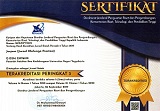Mapping The Potential of Sports Faculties in Indonesia
DOI:
https://doi.org/10.21831/jorpres.v20i1.75672Keywords:
Mapping, Potential, Sports Facilities across IndonesiaAbstract
So far there has been no study that has carried out mapping of study programs, facilities and infrastructure including laboratories and health services offered to the community. Judging from the literature review at all Sports Faculties in Indonesia, the aim of this research is to map the potential of sports faculties throughout Indonesia through study programs, laboratories and service facilities so that the potential of sports faculties is known. This research method involves collecting data from libraries and exploring research objects using various sources of library information, such as books, encyclopaedias, scientific journals, newspapers, magazines, and digital documents. The sample for this literature study consisted of 15 campuses that have sports faculties. Universitas Negeri Yogyakarta has the greatest number of sports study programmes among all campuses. UNM offers a sports faculty provided with appropriate and diverse related laboratories. There are five campuses, namely UPI, UNJA, UNIMA, UNDIKSHA, and UNCEN, which provide limited information about their laboratories. Currently, only UNESA, UM, and UNY have virtually identical quantitative measures. Surabaya and Yogyakarta State Universities own the majority of service facilities, while other sports campuses require new facilities to produce financial resources for universities and provide services to the public and academic community. Collaboration among sports institutions in Indonesia is necessary to cultivate proficient sports graduates across different locations. In addition to fostering healthy rivalry among sports faculties to promote their development, each campus should also seek suitable benchmarks based on their unique qualities, ensuring that each sports faculty have distinct advantages. There is a hope to establish sports universities in Indonesia as part of long-term planning.
References
Achmad Bajuri, F., Furqon Hidayatullah, M., & Kristiyanto, A. (2018). Pemanfaatan Fasilitas Ruang Terbuka/Publik Sebagai Prasarana Olahraga. In Prosiding Seminar Nasional IPTEK Olahraga (Issue 1).
Agarwal, M., & Arora, S. (2020). Sports facility management and higher education institutes. ~ 242 ~ International Journal of Physiology, 5(1).
Araí§ Ilgar, E., & Cihan, B. B. (2018). A Phenomenological Analysis on Evaluation of Sports Management Department Curriculum by Sports Sciences Faculty Members. Journal of Curriculum and Teaching, 7(2), 139. https://doi.org/10.5430/jct.v7n2p139
Bajuri, F. A., Hidayatullah, M. F., Kristiyanto, A., Keolahragaan, I., & Maret, U. S. (2018). Pemanfaatan Fasilitas Ruang Terbuka / Publik Sebagai Prasarana Olahraga. Jurnal Nasional IPTEK Olahraga.
Dwihandaka, R., & Sumarjo, S. (2020). Keefektifan Pemanfaatan dan Arah Pengembangan Laboratorium Prestasi dan Kondisi Fisik FIK UNY. Journal of Physical Activity and Sports (JPAS), 1(1), 124–132. https://doi.org/10.53869/jpas.v1i1.27
Lumingkewas, C. F., & _ I. (2022). PERCEPTION OF STUDENTS ON UNIVERSITY SPORTS FACILITIES - MADE IN FACING EDUCATIONAL SERVICE COMPETITION (A study at the Universitas Klabat Airmadidi, North Minahasa). Abstract Proceedings International Scholars Conference, 7(1). https://doi.org/10.35974/isc.v7i1.1218
Mahony, D. F., Mondello, M., Hums, M. A., & Judd, M. (2006). Recruiting and retaining sport management faculty: Factors affecting job choice. Journal of Sport Management, 20(3). https://doi.org/10.1123/jsm.20.3.414
Mayfield, C. K., Bolia, I. K., Ihn, H., Haratian, A., Hasan, L. K., Hatch, G. F., Petrigliano, F. A., & Weber, A. E. (2021). Evaluation of Sports Medicine Fellowships in the United States Based on Academic Productivity. Journal of the American Academy of Orthopaedic Surgeons Global Research and Reviews, 5(10). https://doi.org/10.5435/JAAOSGlobal-D-21-00165
Muliyani, S. E. (2020). Analisis Kepuasan Mahasiswa Pendidikan Olahraga Ditinjau Dari Fasilitas Olahraga. JISIP (Jurnal Ilmu Sosial Dan Pendidikan), 4(4). https://doi.org/10.36312/jisip.v4i4.1548
Nasrulloh, A., Sumaryanto, S., Sumarjo, S., & Nugroho, S. (2022). Evaluation Study: Functions of Management of Sports Facilities During the COVID-19 Pandemic. Proceedings of the Conference on Interdisciplinary Approach in Sports in conjunction with the 4th Yogyakarta International Seminar on Health, Physical Education, and Sport Science (COIS-YISHPESS 2021), 43. https://doi.org/10.2991/ahsr.k.220106.001
Restivo, M. T., de Fátima Chouzal, M., Abreu, P., & Zvacek, S. (2019). The Role of an Experimental Laboratory in Engineering Education. Advances in Intelligent Systems and Computing, 917, 644–652. https://doi.org/10.1007/978-3-030-11935-5_61
Sciarappa, W. J., Quinn, V., & Ward, D. L. (2016). Comparing conventional, hybrid, and distance learning courses in horticulture. HortTechnology, 26(5), 677–682. https://doi.org/10.21273/HORTTECH03377-16
Young, I. P., Rinehart, J. S., & Place, A. W. (1989). Theories for teacher selection: Objective, subjective, and critical contact. Teaching and Teacher Education, 5(4). https://doi.org/10.1016/0742-051X(89)90030-9
Yudaparmita, G. N. A., Kanca, I. N., Sudiana, I. K., & Dharmadi, M. A. (2023). Hybrid Learning on Pencak Silat Sport in Higher Education: Students' Perception and Issues. Journal of Higher Education Theory and Practice, 23(1), 9–22. https://doi.org/10.33423/jhetp.v23i1.5781
Yulianti, M., Apriani, L., & Makorohim, M. F. (2022). Evaluation of Learning in Hybrid Learning in Sports Physiology Course. JUARA : Jurnal Olahraga, 7(3), 763–773. https://doi.org/10.33222/juara.v7i3.2432
Downloads
Published
How to Cite
Issue
Section
License
Authors who publish with this journal agree to the following terms:
- Authors retain copyright and grant the journal right of first publication with the work simultaneously licensed under a Creative Commons Attribution License that allows others to share the work with an acknowledgement of the work's authorship and initial publication in this journal.
- Authors are able to enter into separate, additional contractual arrangements for the non-exclusive distribution of the journal's published version of the work (e.g., post it to an institutional repository or publish it in a book), with an acknowledgement of its initial publication in this journal.
- Authors are permitted and encouraged to post their work online (e.g., in institutional repositories or on their website) prior to and during the submission process, as it can lead to productive exchanges, as well as earlier and greater citation of published work (See The Effect of Open Access).




